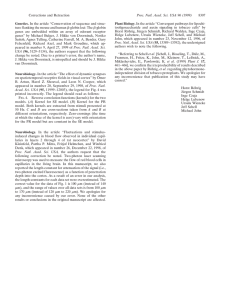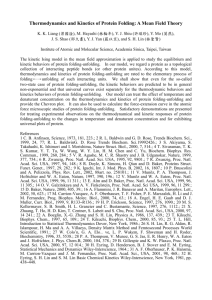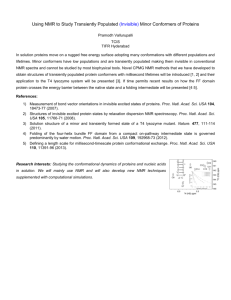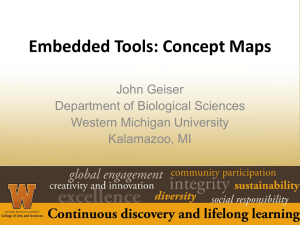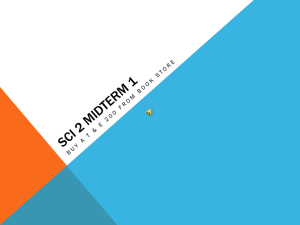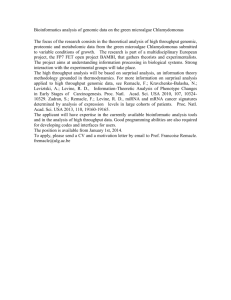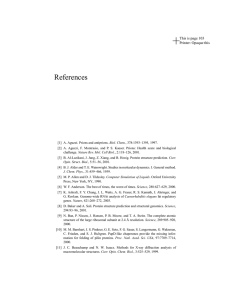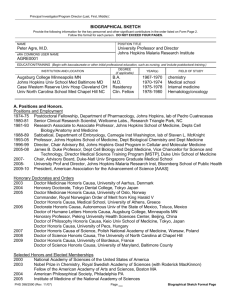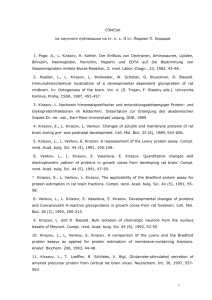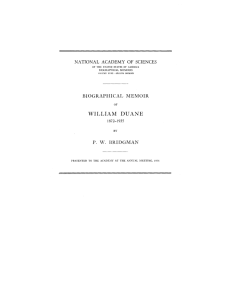Greaves and Maley Review: further reading
advertisement
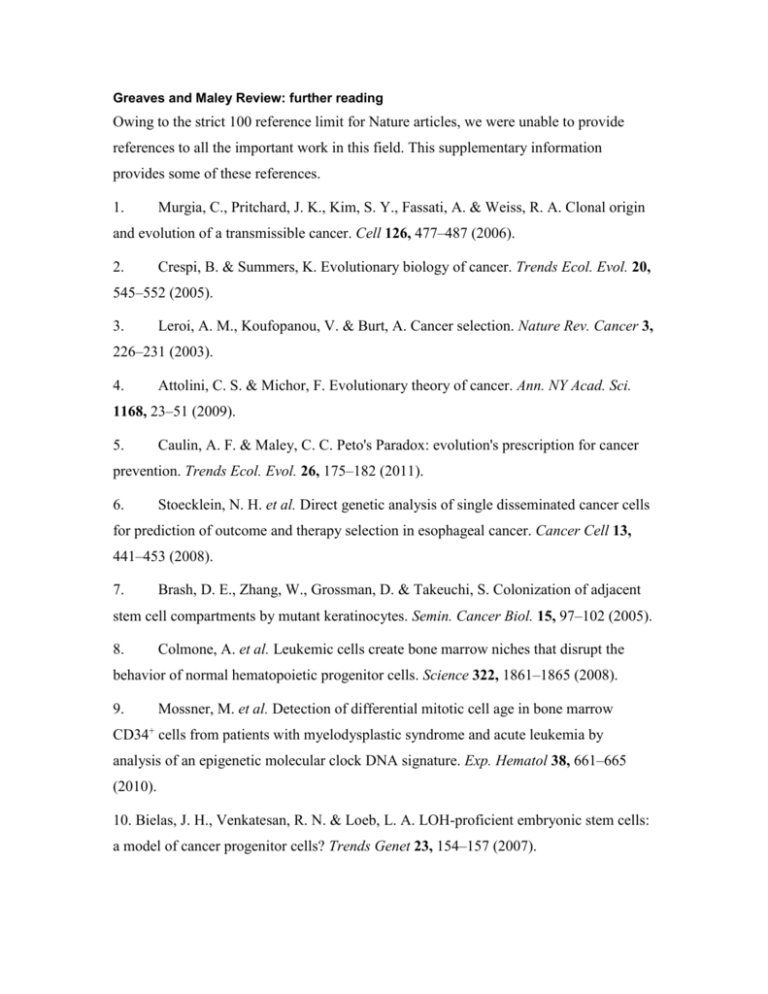
Greaves and Maley Review: further reading Owing to the strict 100 reference limit for Nature articles, we were unable to provide references to all the important work in this field. This supplementary information provides some of these references. 1. Murgia, C., Pritchard, J. K., Kim, S. Y., Fassati, A. & Weiss, R. A. Clonal origin and evolution of a transmissible cancer. Cell 126, 477–487 (2006). 2. Crespi, B. & Summers, K. Evolutionary biology of cancer. Trends Ecol. Evol. 20, 545–552 (2005). 3. Leroi, A. M., Koufopanou, V. & Burt, A. Cancer selection. Nature Rev. Cancer 3, 226–231 (2003). 4. Attolini, C. S. & Michor, F. Evolutionary theory of cancer. Ann. NY Acad. Sci. 1168, 23–51 (2009). 5. Caulin, A. F. & Maley, C. C. Peto's Paradox: evolution's prescription for cancer prevention. Trends Ecol. Evol. 26, 175–182 (2011). 6. Stoecklein, N. H. et al. Direct genetic analysis of single disseminated cancer cells for prediction of outcome and therapy selection in esophageal cancer. Cancer Cell 13, 441–453 (2008). 7. Brash, D. E., Zhang, W., Grossman, D. & Takeuchi, S. Colonization of adjacent stem cell compartments by mutant keratinocytes. Semin. Cancer Biol. 15, 97–102 (2005). 8. Colmone, A. et al. Leukemic cells create bone marrow niches that disrupt the behavior of normal hematopoietic progenitor cells. Science 322, 1861–1865 (2008). 9. Mossner, M. et al. Detection of differential mitotic cell age in bone marrow CD34+ cells from patients with myelodysplastic syndrome and acute leukemia by analysis of an epigenetic molecular clock DNA signature. Exp. Hematol 38, 661–665 (2010). 10. Bielas, J. H., Venkatesan, R. N. & Loeb, L. A. LOH-proficient embryonic stem cells: a model of cancer progenitor cells? Trends Genet 23, 154–157 (2007). 11. Bielas, J. H., Loeb, K. R., Rubin, B. P., True, L. D. & Loeb, L. A. Human cancers express a mutator phenotype. Proc. Natl Acad. Sci. USA 103, 18238–18242 (2006). 12. Michor, F. et al. Dynamics of chronic myeloid leukaemia. Nature 435, 1267–1270 (2005). 13. Yeang, C. H., McCormick, F. & Levine, A. Combinatorial patterns of somatic gene mutations in cancer. FASEB J 22, 2605–2622 (2008). 14. Axelrod, R., Axelrod, D. E. & Pienta, K. J. Evolution of cooperation among tumor cells. Proc. Natl Acad. Sci. USA 103, 13474–13479 (2006). 15. Basanta, D. et al. The role of transforming growth factor-beta-mediated tumor-stroma interactions in prostate cancer progression: an integrative approach. Cancer Res. 69, 7111–7120 (2009). 16. Romanov, S. R. et al. Normal Human Mammary Epithelial Cells Spontaneously Escape Senescence and Acquire Genomic Changes. Nature 409, 633–637 (2001). 17. Domazet-Loso, T. & Tautz, D. Phylostratigraphic tracking of cancer genes suggests a link to the emergence of multicellularity in metazoa. BMC Biol. 8, 66 (2010). 18. Marusyk, A. et al. Irradiation alters selection for oncogenic mutations in hematopoietic progenitors. Cancer Res. 69, 7262–7269 (2009). 19. Nunney, L. The population genetics of multistage carcinogenesis. Proc. Biol. Sci. 270, 1183–1191 (2003). 20. Eaton, S. B. et al. Women's reproductive cancers in evolutionary context. Q. Rev. Biol. 69, 353–367 (1994). 21. Seluanov, A. et al. Distinct tumor suppressor mechanisms evolve in rodent species that differ in size and lifespan. Aging Cell 7, 813–823 (2008). 22. Heng, H. H. et al. Stochastic cancer progression driven by non-clonal chromosome aberrations. J Cell. Physiol. 208, 461–472 (2006). 23. Aktipis, C. A., Maley, C. C. & Pepper, J. W. Dispersal evolution in neoplasms: The role of disregulated metabolism in the evolution of cell motility. Cancer Prev Res (Phila.) doi:10.1158/1940-6207.CAPR-11-0004 (2011). 24. Anderson, A. R., Weaver, A. M., Cummings, P. T. & Quaranta, V. Tumor morphology and phenotypic evolution driven by selective pressure from the microenvironment. Cell 127, 905–915 (2006). 25. Franklin, W. A. et al. Widely dispersed p53 mutation in respiratory epithelium. A novel mechanism for field carcinogenesis. J. Clin. Invest. 100, 2133–2137 (1997). 26. Smith, G. et al. Mutations in APC, Kirsten-ras, and p53-alternative genetic pathways to colorectal cancer. Proc. Natl Acad. Sci. USA 99, 9433–9438 (2002). 27. Frumkin, D. et al. Cell lineage analysis of a mouse tumor. Cancer Res. 68, 5924– 5931 (2008). 28. Fidler, I. J. & Kripke, M. L. Metastasis results from pre-existing variant cells within a malignant tumor. Science 197, 893–895 (1977). 29. Loberg, R. D. et al. Targeting CCL2 with systemic delivery of neutralizing antibodies induces prostate cancer tumor regression in vivo. Cancer research 67, 9417–9424, (2007). 30. Frank, S. A., Chen, P. C. & Lipkin, S. M. Kinetics of cancer: a method to test hypotheses of genetic causation. BMC Cancer 5, 163 (2005). 31. Davies, P. C. & Lineweaver, C. H. Cancer tumors as Metazoa 1.0: tapping genes of ancient ancestors. Phys. Biol. 8, 015001(2011). 32. Graham, T. A. et al. Use of methylation patterns to determine expansion of stem cell clones in human colon tissue. Gastroenterology 140, 1241–1250 (2011). 33. Thirlwell, C. et al. Clonality assessment and clonal ordering of individual neoplastic crypts shows polyclonality of colorectal adenomas. Gastroenterology 138, 1441–1454, (2010). 34. Komarova, N. L. & Wodarz, D. Drug resistance in cancer: principles of emergence and prevention. Proc. Natl Acad. Sci. USA 102, 9714–9719 (2005). 35. Ruiz, C. et al. Advancing a clinically relevant perspective of the clonal nature of cancer. Proc. Natl Acad. Sci. USA 108, 12054–12059 (2011). Cancer genomics: 36. Sjoblom, T. et al. The consensus coding sequences of human breast and colorectal cancers. Science 314, 268–274 (2006). 37. Campbell, P. J. et al. The patterns and dynamics of genomic instability in metastatic pancreatic cancer. Nature 467,1109–1113 (2010). 38. Liu, W. et al. Copy number analysis indicates monoclonal origin of lethal metastatic prostate cancer. Nature Med 15, 559–565 (2009). 39. Pleasance, E. D. et al. A small-cell lung cancer genome with complex signatures of tobacco exposure. Nature 463, 184–190 (2009). 40. Shah, S. P. et al. Mutational evolution in a lobular breast tumour profiled at single nucleotide resolution. Nature 461, 809–813 (2009). Early work leading to Nowell’s clonal evolutionary theory of cancer 41. Boveri, T. The Origin of Malignant Tumours (trans.). (Willimas and Wilkins, 1929). 42.Foulds, L. The experimental study of tumor progression: a review. Cancer Res. 14, 317–339 (1954). 43. Nordling, C. O. A new theory on cancer-inducing mechanism. British journal of cancer 7, 68–72 (1953). 44. Armitage, P. & Doll, R. The age distribution of cancer and a multi-stage theory of carcinogenesis. Br. J. Cancer 8, 1–12 (1954). 45. Levan, A. & Biesele, J. J. Role of chromosomes in cancerogenesis, as studied in serial tissue culture of mammalian cells. Ann. NY Acad. Sci. 71, 1022–1053 (1958). 46. Hauschka, T. S. The chromosomes in ontogeny and oncogeny. Cancer Res. 21, 957– 974 (1961). 47. Ford, C. E. & Clarke, C. M. Cytogenetic evidence of clonal proliferation in primary reticular neoplasms. Can. Cancer Conf. 5, 129–146 (1963). 48. de Grouchy, J., de Nava, C., Cantu, J. M., Bilski-Pasquier, G. & Bousser, J. Models for clonal evolutions: a study of chronic myelogenous leukemia. Am. J. Hum. Genet. 18, 485–503 (1966). 49.Yosida, T. H. Relation between chromosomal alteration and development of tumors. Jpn J Genetics 41, 439–451 (1966). 50. de Grouchy, J. & de Nava, C. A chromosomal theory of carcinogenesis. Ann Intern Med 69, 381–391 (1968). 51.Knudson, A. G., Jr. Mutation and cancer: statistical study of retinoblastoma. Proc. Natl Acad. Sci. USA 68, 820–823 (1971). 52. Muto, T., Bussey, H. J. & Morson, B. C. The evolution of cancer of the colon and rectum. Cancer 36, 2251–2270 (1975). 53. Cairns, J. Mutation selection and the natural history of cancer. Nature 255, 197–200 (1975). Evidence of selection (on cancer stem cells) in therapeutic resistance: 54. Roche-Lestienne, C. & Preudhomme, C. Mutations in the ABL kinase domain preexist the onset of imatinib treatment. Semin. Hematol. 40, 80–82 (2003). 55. Mullighan, C. G. et al. Genomic analysis of the clonal origins of relapsed acute lymphoblastic leukemia. Science 322, 1377–1380 (2008). 56. Bachas, C. et al. High-frequency type I/II mutational shifts between diagnosis and relapse are associated with outcome in pediatric AML: implications for personalized medicine. Blood 116, 2752–2758 (2010). 57. Shah, N. P. et al. Sequential ABL kinase inhibitor therapy selects for compound drugresistant BCR-ABL mutations with altered oncogenic potency. J. Clin. Invest. 117, 2562– 2569 (2007). 58. Seliger, B. Strategies of tumor immune evasion. BioDrugs 19, 347–354 (2005). 59. Turke, A. B. et al. Preexistence and clonal selection of MET amplification in EGFR mutant NSCLC. Cancer Cell 17, 77–88 (2010). 60. Branford, S. et al. High frequency of point mutations clustered within the adenosine triphosphate-binding region of BCR/ABL in patients with chronic myeloid leukemia or Ph-positive acute lymphoblastic leukemia who develop imatinib (STI571) resistance. Blood 99, 3472–3475 (2002). 61. Carman, M. D. et al. Resistance to methotrexate due to gene amplification in a patient with acute leukemia. J. Clin. Oncol. 2, 16–20 (1984). 62. Chen, L. L. et al. A missense mutation in KIT kinase domain 1 correlates with imatinib resistance in gastrointestinal stromal tumors. Cancer Res. 64, 5913–5919 (2004). 63. Edwards, J., Krishna, N. S., Witton, C. J. & Bartlett, J. M. Gene amplifications associated with the development of hormone-resistant prostate cancer. Clin. Cancer Res. 9, 5271–5281 (2003). 64. Engelman, J. A. et al. MET amplification leads to gefitinib resistance in lung cancer by activating ERBB3 signaling. Science 316, 1039–1043 (2007). 65. Gorre, M. E. et al. Clinical resistance to STI-571 cancer therapy caused by BCR-ABL gene mutation or amplification. Science 293, 876–880 (2001). 66. Horns, R. C., Jr., Dower, W. J. & Schimke, R. T. Gene amplification in a leukemic patient treated with methotrexate. J. Clin. Oncol. 2, 2–7 (1984). 67. Kobayashi, S. et al. EGFR mutation and resistance of non-small-cell lung cancer to gefitinib. N. Engl. J. Med. 352, 786–792 (2005). 68. Tamborini, E. et al. A new mutation in the KIT ATP pocket causes acquired resistance to imatinib in a gastrointestinal stromal tumor patient. Gastroenterology 127, 294–299 (2004). 69. Visakorpi, T. et al. In vivo amplification of the androgen receptor gene and progression of human prostate cancer. Nature Genet 9, 401–406 (1995). 70. Wang, T. L. et al. Digital karyotyping identifies thymidylate synthase amplification as a mechanism of resistance to 5-fluorouracil in metastatic colorectal cancer patients. Proc. Natl Acad. Sci. USA 101, 3089–3094 (2004). 71. Taplin, M. E. et al. Selection for androgen receptor mutations in prostate cancers treated with androgen antagonist. Cancer Res. 59, 2511–2515 (1999). Evolutionary methods useful for cancer biology: 72. Drummond, A. J., Ho, S. Y., Phillips, M. J. & Rambaut, A. Relaxed phylogenetics and dating with confidence. PLoS Biol. 4, e88 (2006). 73. Felsenstein, J. Inferring Phylogenies. (2004). 74. Brodie, E. D., 3rd, Moore, A. J. & Janzen, F. J. Visualizing and quantifying natural selection. Trends Ecol. Evol. 10, 313– 318 (1995). 75.Felsenstein, J. Comparative methods with sampling error and within-species variation: contrasts revisited and revised. Am. Nat. 171, 713–725 (2008). 76. Donnelly, P., Nordborg, M. & Joyce, P. Likelihoods and simulation methods for a class of nonneutral population genetics models. Genetics 159, 853–867 (2001). 77. Kuhner, M. K. & Smith, L. P. Comparing likelihood and Bayesian coalescent estimation of population parameters. Genetics 175, 155–165 (2007). 78. Opgen-Rhein, R., Fahrmeir, L. & Strimmer, K. Inference of demographic history from genealogical trees using reversible jump Markov chain Monte Carlo. BMC Evol. Biol. 5, 6 (2005). 79. Takezaki, N., Rzhetsky, A. & Nei, M. Phylogenetic test of the molecular clock and linearized trees. Mol Biol and Evol 12, 823–833 (1995). 80. Seo, T. K., Thorne, J. L., Hasegawa, M. & Kishino, H. A viral sampling design for testing the molecular clock and for estimating evolutionary rates and divergence times. Bioinformatics 18, 115–123 (2002). Cancer stem cells and signatures of self-renewal: 81. Dierks, C. et al. Expension of Bcr-Abl-positive leukemic stem cells is dependent on hedgehog pathway activation. Cancer Cell 14, 238–249 (2008). 82. Yilmaz, O. H. et al. Pten dependence distinguishes haematopoietic stem cells from leukaemia-initiating cells. Nature 441, 475–482 (2006). 83. Ben-Porath, I. et al. An embryonic stem cell-like gene expression signature in poorly differentiated aggressive human tumors. Nature Genet. 40, 499–507 (2008).
